Avoid A Construction Project
Upgrade to a Heat Pump Without Ditching Your Existing Electric Heaters
As energy costs fluctuate and climate concerns grow, many homeowners and building managers are looking to switch to high-efficiency heating and cooling systems like heat pumps. But one common concern is what to do with existing electric heaters, especially in homes that rely on baseboard or in-wall units for warmth. The good news? You don’t have to rip them out and it will actually save you money and keep you more comfortable in the long run.
With King’s ThermaLink™ KRF-B-KIT, you can keep your existing electric heaters in place and control them wirelessly as a backup to your new heat pump system. No expensive wall repairs, no major rework—just a smart, efficient upgrade.

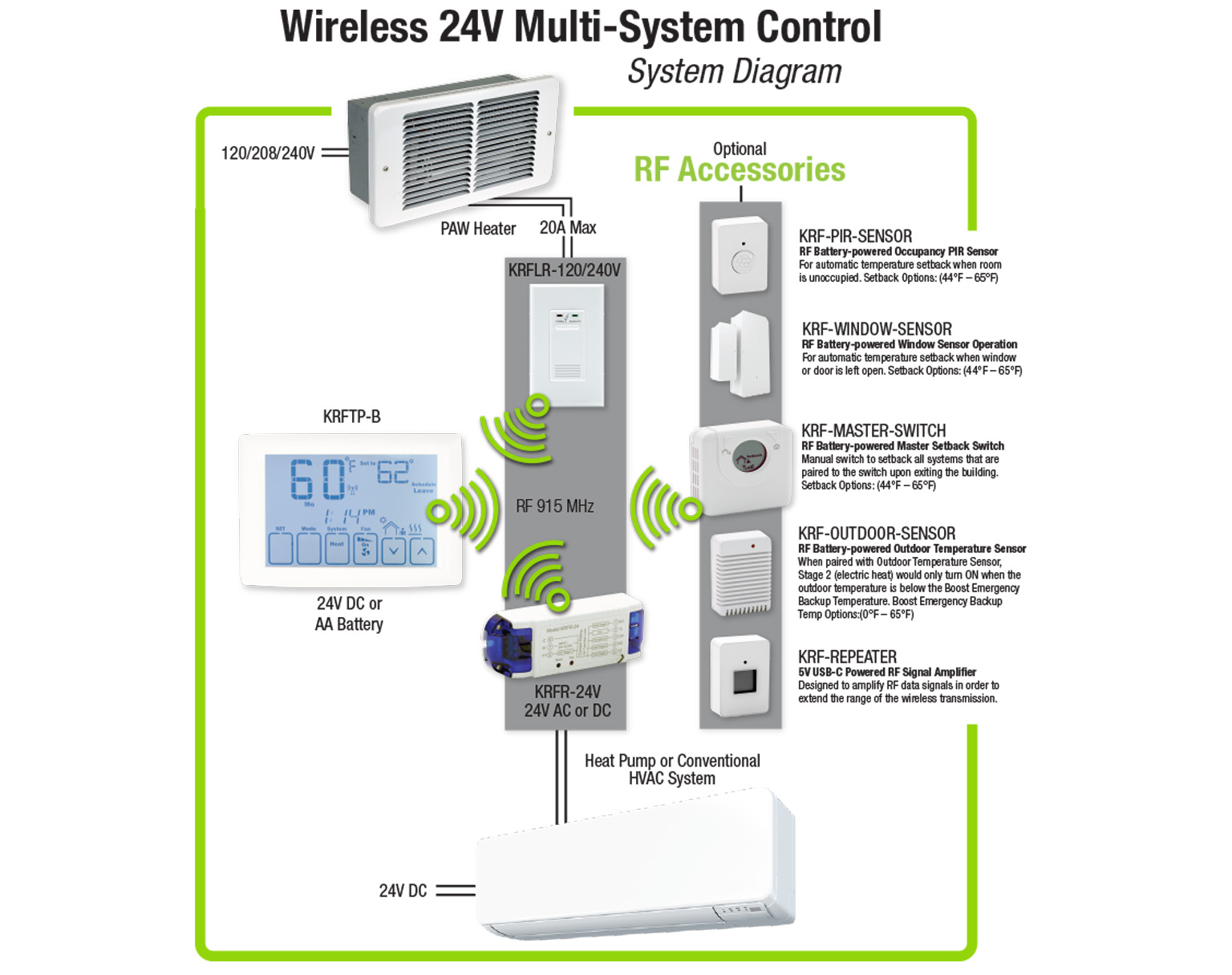
Why Upgrade to a Heat Pump?
Heat pumps are a game-changer for energy efficiency. Unlike traditional electric resistance heating, heat pumps transfer heat instead of generating it, using up to 3 times less electricity. They offer both heating and cooling, making them an all-in-one solution for year-round comfort.
However, heat pumps can struggle to maintain optimal indoor temperatures during extremely cold weather.
That’s where backup heating comes in—and this is where your existing electric heaters can shine.
Keep Your Electric Heaters – and Your Walls – Intact
Instead of tossing them out, why not let your electric heaters act as auxiliary heat for those super-chilly days? The key is to integrate them with your new heat pump system in a smart and efficient way, so your system meets local Energy Code requirements.
This is where the ThermaLink™ Multi-System Platform comes in.
One of the biggest hidden costs of removing electric heaters is wall repairs. Whether it’s patching drywall, repainting, or redoing trim, taking out electric heaters can quickly turn into a construction project and Thermalink prevents those hassles.
The Benefits Of Integrating Your Existing Electric Heaters As A Backup System
Avoid Patching Holes In Walls & Baseboards
-
By keeping your current electric heaters, you eliminate the need to tear into walls or baseboards, avoiding messy patchwork and repairs.
Save On Labor & Materials
-
Utilizing existing equipment significantly reduces the need for extra materials and costly labor during installation.
Shorten Your Installation Timeline
-
Since much of the infrastructure is already in place, the overall installation process is faster and more efficient.
Preserve The Aesthetics Of Your Space
-
Keeping your current electric heaters helps keep your home’s interior design intact without disruptive alterations.
How ThermaLink™ Makes It Work
ThermaLink™ is a smart 24V Wireless RF Thermostat Platform designed to operate your electric heaters as part of a modern, efficient heating system. It’s a Multi-System Platform That Runs Itself, Adapting To A Building’s Ever Changing Climate Demands, providing control over a heat pump’s heating & cooling plus reliable backup line voltage electric heat. The kit includes a 7-day programmable wireless RF thermostat, a 120/240V 20A electric heat relay, and a 24V heat pump relay.
Here’s a simplified breakdown of how to install the system:
1. Install the new Heat Pump System
Begin by installing your new heat pump, which will now serve as the primary source of heating and cooling for your home. Modern heat pumps are highly efficient, providing year-round comfort by transferring heat in or out of your home depending on the season. This foundational step establishes the main climate control system you’ll rely on most of the time.
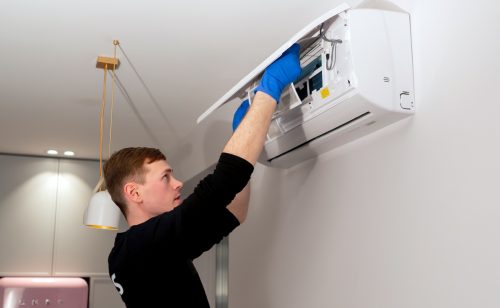
2. Retain Existing Electric Heaters
Instead of removing your baseboard or wall-mounted electric heaters, simply leave them in place. These units will serve as a backup heat source, kicking in only when additional warmth is needed. This approach avoids the cost and hassle of demolition and repair, and keeps a reliable supplemental system in place for colder days.
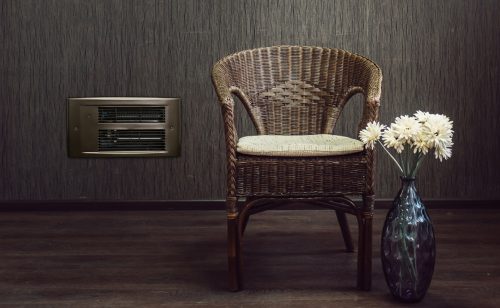
3. Install KRFTP-B 24V RF Wireless Thermostat
Mount the KRFTP-B wireless thermostat in a central location. While it’s battery-powered out of the box, it includes R and C terminals that allow for connection to a 24V power source—so you can eliminate the need to replace batteries over time. The thermostat serves as the central control unit for both the heat pump and your backup electric heaters, communicating wirelessly with each.
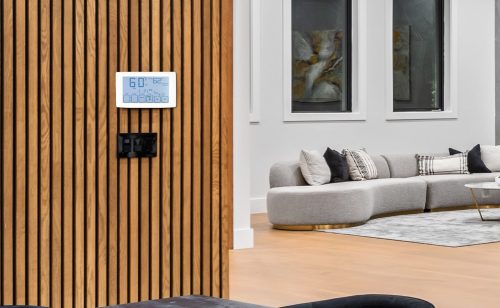
4. Install KRFR-24V 24-Volt Wireless Relay Control Module on the Heat Pump
Next, wire the KRFR-24V module directly to your heat pump. This 24V wireless relay receives RF (radio frequency) signals from the KRFTP-B thermostat to control the heating and cooling stages of the heat pump. No need to run new control wires through walls—the RF connection simplifies the installation while offering reliable performance.
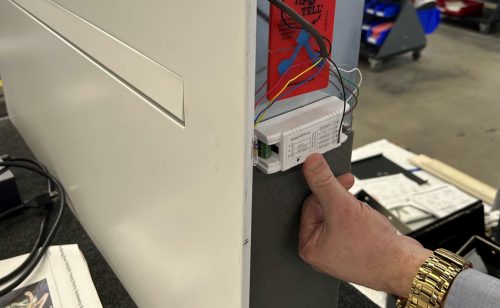
5. Pair the KRFR-24V Heat Pump Relay to the KRFTP-B Thermostat
Follow the pairing instructions to wirelessly connect the KRFTP-B Thermostat to the KRFLR-24V Relay via RF signal.
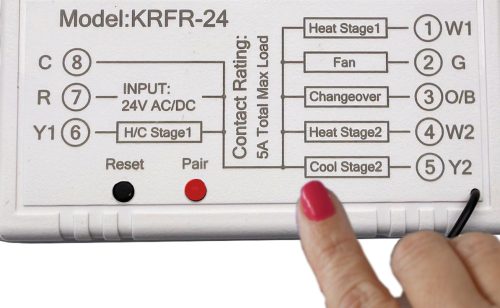
6. Install KRFLR-120/240V 20A Heating Relay Control Module
Replace the existing wall thermostats connected to your electric heaters with the KRFLR relay modules. Each unit is hardwired to its respective heater and connects wirelessly with the central thermostat. This setup enables remote control of the backup heating system, activating it only when supplemental heat is necessary, ensuring efficient and seamless integration with your new heat pump.
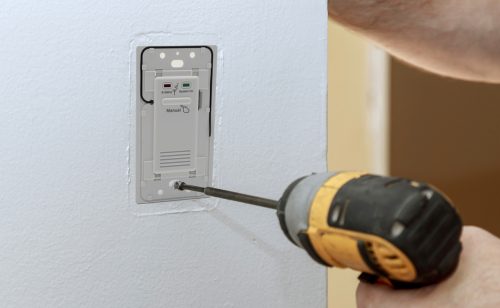
7. Pair the KRFLR-120/240V Heater Relay to the KRFTP-B Thermostat
Follow the pairing instructions to wirelessly connect the KRFTP-B Thermostat to the KRFLR Relay via RF signal.
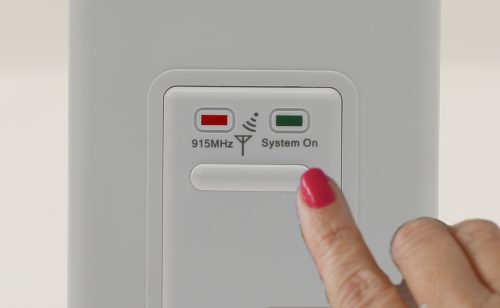
8. Add Optional RF Sensors (if desired)
Install and pair any additional RF sensors, such as occupancy, window/door, outdoor sensor or master setback switches, for enhanced control and energy efficiency.
- RF Occupancy PIR Sensor: Automatically reduces the temperature when the room is unoccupied, helping save energy.
- RF Window/Door Sensor: Detects when a window or door is open and adjusts the heating accordingly to prevent heat loss.
- RF Outdoor Sensor: Electric Backup Heat would only turn ON when the outdoor temperature drops below the Boost Emergency Backup Temperature. (0°F – 65°F)
- RF Master Setback Switch: Provides manual control to lower the temperature across all thermostats when leaving the building, further reducing energy waste.
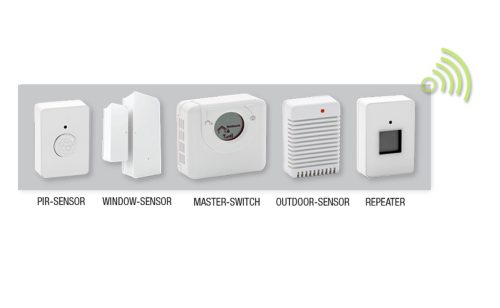
9. Program Your 7-day Heating and Cooling Schedule
With all hardware installed, use the ThermaLink thermostat to program a customized 7-day schedule that fits your lifestyle. Set different temperatures for morning, day, evening, and night, and let the system automatically switch between your heat pump and backup heaters to maintain comfort and efficiency throughout the week.
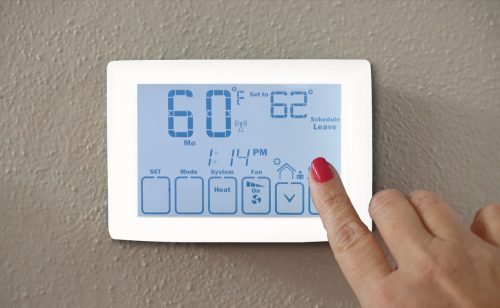
The Hybrid Heating Advantage
 Smarter Energy Use
Smarter Energy Use
With ThermaLink™ at the heart of your hybrid setup, the system intelligently decides when to use the heat pump and when to engage the electric heaters. ThermaLink ensures that you’re always using the most energy-efficient heating source at any given time—reducing waste and maximizing performance automatically.
 Cost Savings
Cost Savings
There’s no need to tear out existing electric heaters, which means no demolition, no patching, and no repainting. This not only cuts down on labor and materials, but also shortens your overall project timeline—delivering a quicker return on investment.
 Meets Energy Code Requirements
Meets Energy Code Requirements
Modern energy codes often require primary heating systems—like heat pumps—to handle most of the heating load. The hybrid approach meets these requirements beautifully. Your heat pump takes the lead, handling everyday heating needs efficiently, while the electric heaters only activate during demand spikes or extreme cold.
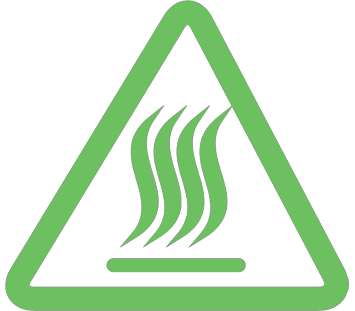 Enhanced Comfort
Enhanced Comfort
When the temperature really drops, even the best heat pumps can struggle to keep up on their own. With a hybrid setup, your existing electric heaters automatically step in as a supplemental heat source during those colder periods, providing consistent warmth throughout your home.
The Bottom Line
Upgrading to a heat pump doesn’t mean you have to abandon your existing electric heaters. With smart tools like King Electric’s THERMALINK™, you can create a hybrid system that’s energy-efficient, cost-effective, and ultra-reliable.
If you’re planning a heating system upgrade, consider keeping your electric heaters in play. Paired with a modern controller, they can be the perfect safety net for your new, eco-friendly comfort system —with no wall damage, no mess, and no compromises.